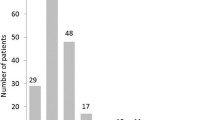Abstract
The objective of this study was to evaluate characteristics that discriminate prolactinoma from non-functioning pituitary macroadenoma with hyperprolactinemia. We included 117 patients with hyperprolactinemic pituitary macroadenomas. Patients were divided into three groups according to treatment outcomes and pathologic results: (A) prolactinoma that responded to dopamine agonist (DA) treatment (PRDA); (B) prolactinoma requiring surgical treatment (PRS); and (C) non-functioning pituitary adenoma with hyperprolactinemia (NFPAH). Old age, low serum prolactin levels, and extrasellar extension were associated with NFPAH. Most patients with NFPAH had serum prolactin levels less than 100 ng/ml. Visual defects and GH deficiency were more common in patients with NFPAH compared with patients with PRS and PRDA, without difference of tumor size. Galactorrhea and amenorrhea were less frequent in patients with NFPAH than in patients with PRS and PRDA. Post-operative remission of hyperprolactinemia was achieved in 100% of patients with NFPAH and in 72.5% of patients with PRS. DA administration was required in 25.5% of patients with PRS; however, no patients with NFPAH required DA administration. In conclusion, old age, extrasellar tumor extension with relatively low prolactin levels, visual defect, and GH deficiency were considered suggestive of non-functioning pituitary adenoma rather than prolactinoma in hyperprolactinemic pituitary macroadenoma.


Similar content being viewed by others
References
T. Mancini, F.F. Casanueva, A. Giustina, Hyperprolactinemia and prolactinomas. Endocrinol. Metab. Clin. North Am. 37(1), 67–99 (2008). (viii)
H. Kronenberg, R.H. Williams, Williams Textbook of Endocrinology, 11th edn. (Elsevier Saunders, Philadelphia, PA, 2008)
J.A. Schlechte, Clinical practice. Prolactinoma. N. Engl. J. Med. 349(21), 2035–2041 (2003)
A. Colao, C. Di Somma, R. Pivonello, A. Faggiano, G. Lombardi, S. Savastano, Medical therapy for clinically non-functioning pituitary adenomas. Endocr. Relat. Cancer 15(4), 905–915 (2008)
P. Chanson, Gonadotroph pituitary adenomas. Ann. Endocrinol. (Paris) 61(3), 258–268 (2000)
W.F. Young, B.W. Scheithauer, K.T. Kovacs, E. Horvath, D.H. Davis, R.V. Randall, Gonadotroph adenoma of the pituitary gland: a clinicopathologic analysis of 100 cases. Mayo Clin. Proc. 71(7), 649–656 (1996)
M.E. Molitch, Pharmacologic resistance in prolactinoma patients. Pituitary 8(1), 43–52 (2005)
P. Chanson, S. Brochier, Non-functioning pituitary adenomas. J. Endocrinol. Invest. 28(11 Suppl International), 93–99 (2005)
M.S. Yang, S.H. Kim, S.G. Lim, S.K. Lee, The effect of bromocriptine treatment for invasive prolactinoma. J. Korean Neurosurg. Soc. 37(4), 275–281 (2005)
A. Ciccarelli, A.F. Daly, A. Beckers, The epidemiology of prolactinomas. Pituitary 8(1), 3–6 (2005)
M. Buchfelder, R. Fahlbusch, C. Ladar, P. Nomikos, Impact of primary surgery on pituitary function in patients with non-functioning pituitary adenomas—a study on 721 patients. Acta Neurochir. 146(1), 27–35 (2004)
E. Ferrante, M. Ferraroni, T. Castrignan, L. Menicatti, M. Anagni, G. Reimondo, P. Del Monte, D. Bernasconi, P. Loli, M. Faustini-Fustini, G. Borretta, M. Terzolo, M. Losa, A. Morabito, A. Spada, P. Beck-Peccoz, A.G. Lania, Non-functioning pituitary adenoma database: a useful resource to improve the clinical management of pituitary tumors. Eur. J. Endocrinol. 155(6), 823–829 (2006)
M.L. Cury, J.C. Fernandes, H.R. Machado, L.L. Elias, A.C. Moreira, M. Castro, Non-functioning pituitary adenomas: clinical feature, laboratorial and imaging assessment, therapeutic management and outcome. Arq. Bras. Endocrinol. Metabol. 53(1), 31–39 (2009)
B.M. Arafah, D. Prunty, J. Ybarra, M.L. Hlavin, W.R. Selman, The dominant role of increased intrasellar pressure in the pathogenesis of hypopituitarism, hyperprolactinemia, and headaches in patients with pituitary adenomas. J. Clin. Endocrinol. Metab. 85(5), 1789–1793 (2000)
J.A. Wass, H.E. Turner, N. Meston, O. Ansorge, R. Trifanescu, H.C. Shore, G. Thanabalasingham, N. Karavitaki, Do the limits of serum prolactin in disconnection hyperprolactinaemia need re-definition? A study of 226 patients with histologically verified non-functioning pituitary macroadenoma. Clin. Endocrinol. (Oxf) 65(4), 524–529 (2006)
R. Fahlbusch, M. Buchfelder, I. Lancranjan, R.V. Lloyd, E. Horvath, L. Stefaneanu, K. Kovacs, Effect of dopamine agonist medication on prolactin producing pituitary adenomas. A morphological study including immunocytochemistry, electron microscopy and in situ hybridization. Virchows Arch. A Pathol. Anat. Histopathol. 418(5), 439–446 (1991)
M. Scanarini, Morphological changes in prolactinoma induced by bromocriptine treatment. Minerva Endocrinol. 15(1), 13–15 (1990)
N. Kageyama, T. Katoh, A. Kuwayama, T. Takahashi, Histological changes and operative findings of pituitary adenomas after bromocriptine treatment. Nippon Naibunpi Gakkai Zasshi 62(12), 1336–1351 (1986)
J.S. Bevan, J. Webster, C.W. Burke, M.F. Scanlon, Dopamine agonists and pituitary tumor shrinkage. Endocr. Rev. 13(2), 220–240 (1992)
B. Stoffel-Wagner, N. Bliesener, R.A. Kristof, S. Hoven, M. Wichers-Rother, Non-functioning pituitary adenomas: endocrinological and clinical outcome after transsphenoidal and transcranial surgery. Exp. Clin. Endocrinol. Diabetes 112(6), 323–327 (2004)
C.A. Jaffe, Clinically non-functioning pituitary adenoma. Pituitary 9(4), 317–321 (2006)
M. Losa, P. Mortini, R. Barzaghi, L. Gioia, M. Giovanelli, Surgical treatment of prolactin-secreting pituitary adenomas: early results and long-term outcome. J. Clin. Endocrinol. Metab. 87(7), 3180–3186 (2002)
T.Y. Jung, J.H. Kim, I.Y. Kim, T.S. Kim, S. Jung, S.H. Kim, Surgical outcome of pituitary prolactinomas. J. Korean Neurosurg. Soc. 32(4), 307–311 (2002)
M. Buchfelder, R. Fahlbusch, C. Nimsky, B. Hofmann, H. Wallaschofski, R. Buslei, J. Kreutzer, Operative treatment of prolactinomas: indications and results in a current consecutive series of 212 patients. Eur. J. Endocrinol. 158(1), 11–18 (2008)
C.B. Wilson, C.B. Applebury, L.T. Hannegan, K.R. Lamborn, J.B. Tyrrell, Transsphenoidal microsurgical therapy of prolactinomas: initial outcomes and long-term results. Neurosurgery 44(2), 254–261 (1999). (discussion 261)
D.K. Ldecke, T. Abe, Transnasal surgery for prolactin-secreting pituitary adenomas in childhood and adolescence. Surg. Neurol. 57(6), 369–378 (2002). (discussion 378)
Acknowledgments
We are grateful to Suil Ji for performing the immunohistochemistry analyses used in this study. No potential conflict of interest relevant to this article was reported. Nothing to declare.
Author information
Authors and Affiliations
Corresponding authors
Rights and permissions
About this article
Cite this article
Hong, J.W., Lee, M.K., Kim, S.H. et al. Discrimination of prolactinoma from hyperprolactinemic non-functioning adenoma. Endocr 37, 140–147 (2010). https://doi.org/10.1007/s12020-009-9279-7
Received:
Accepted:
Published:
Issue Date:
DOI: https://doi.org/10.1007/s12020-009-9279-7




